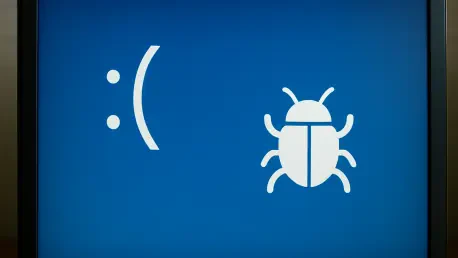I’m thrilled to sit down with Rupert Marais, our in-house security specialist with deep expertise in endpoint and device security, cybersecurity strategies, and network management. Today, we’re diving into the urgent topic of Microsoft’s emergency patch for a critical Windows Server bug, known as CVE-2025-59287. This vulnerability has sparked widespread concern due to its high severity, active exploitation in the wild, and the challenges Microsoft faced in fully addressing it. Our conversation will explore the nature of this flaw, the implications of its exploitation, and the steps organizations can take to protect themselves in this rapidly evolving threat landscape.
Can you break down what CVE-2025-59287 is and why it’s considered such a critical vulnerability in Windows Server Update Service?
Absolutely. CVE-2025-59287 is a remote code execution flaw in the Windows Server Update Service, or WSUS, which is a tool used by administrators to manage and deploy updates across networks. What makes this vulnerability so dangerous is that it allows attackers to execute code remotely on affected systems by exploiting a weakness in how WSUS handles certain data through a legacy serialization mechanism. It scored a near-perfect 9.8 on the CVSS scale because it requires no user interaction, can be exploited over the network, and gives attackers full control over the compromised system. Essentially, it’s a wide-open door for malicious actors if left unpatched.
What specific part of WSUS is affected by this flaw, and how does it enable remote code execution?
The issue lies in how WSUS processes AuthorizationCookie objects at a specific endpoint called GetCookie(). These objects are deserialized using an outdated mechanism called BinaryFormatter, which lacks proper type validation. Attackers can craft malicious data that, when deserialized, triggers unsafe behavior, allowing them to run arbitrary code on the server. It’s a classic case of a legacy component not keeping up with modern security standards, creating a critical weak point in an otherwise robust system.
Microsoft released an initial patch for this in their October update, but it didn’t fully resolve the issue. Can you explain what went wrong with that first attempt?
From what we know, the initial patch released during October’s Patch Tuesday didn’t completely close the vulnerability. Microsoft acknowledged that it failed to fully mitigate the risk, though they haven’t detailed exactly where it fell short. My guess is that the patch addressed only part of the exploit path—perhaps a specific attack vector—but left other avenues open for exploitation. This is not uncommon with complex flaws like this, where the full scope of the issue might not be apparent until further testing or real-world attacks reveal additional weaknesses.
How did Microsoft realize the first patch wasn’t enough, and what did they do next?
It’s likely that feedback from the cybersecurity community, including researchers and firms who analyzed the flaw, played a big role in identifying the gaps. After recognizing the problem, Microsoft quickly rolled out an emergency patch to comprehensively address the vulnerability. They’ve confirmed that systems with the latest update are now protected, showing a proactive response to ensure organizations aren’t left vulnerable while attackers are actively exploiting this flaw.
Speaking of exploitation, there have been reports of attackers already targeting CVE-2025-59287. What can you tell us about the current threat activity?
Yes, this vulnerability is under active exploitation, which is why it’s such an urgent issue. Cybersecurity researchers started noticing attack activity almost immediately after the flaw became public knowledge, with reports of exploitation kicking off within days of the initial disclosure. Threat actors are targeting WSUS instances, especially those exposed to the internet on default ports like 8530 and 8531. It’s a race against time for organizations to patch their systems before they become the next victim.
What types of systems or environments are most at risk from these attacks?
Systems running WSUS with the Server Role enabled are the primary targets, particularly if they’re publicly accessible. If an organization has WSUS configured to listen on those default ports without proper firewall protections, it’s essentially an open invitation for attackers. Large enterprises or managed service providers who rely on WSUS for update management across multiple servers are especially vulnerable because a single breach could cascade across their network.
The Cybersecurity and Infrastructure Security Agency added this flaw to its Known Exploited Vulnerabilities Catalog. Why is that significant for organizations?
Being listed in CISA’s Known Exploited Vulnerabilities Catalog is a big deal because it signals that this flaw isn’t just a theoretical risk—it’s being actively used by attackers in real-world scenarios. For organizations, especially those in regulated industries or working with federal agencies, this listing often comes with a mandate to patch within a tight deadline. It’s a wake-up call to prioritize remediation and underscores the urgency of addressing this vulnerability before it’s exploited in their environment.
Microsoft has offered some temporary workarounds for organizations that can’t patch immediately. Can you walk us through those recommendations?
Sure. Microsoft suggests two main temporary mitigations. First, organizations can disable the WSUS Server Role if it’s not critical to their operations. This isn’t enabled by default on Windows Server, so if you’ve turned it on, you can reverse that through the Server Manager to reduce exposure. Second, they recommend blocking inbound traffic to ports 8530 and 8531 on host firewalls. These are the default ports WSUS uses, and closing them off prevents attackers from reaching the vulnerable service from outside the network. Both are stopgap measures, but they buy time until the patch can be applied.
What are some potential challenges or downsides to implementing these temporary fixes?
Disabling the WSUS Server Role can disrupt update management, especially in larger environments where centralized patching is critical. Organizations might need alternative ways to deploy updates, which can be resource-intensive. Blocking those ports is generally safer, but if WSUS needs to communicate with external clients or other servers, this could break functionality. It’s a trade-off between security and operational continuity, and each organization needs to weigh the risks based on their setup.
Looking ahead, what is your forecast for the impact of vulnerabilities like CVE-2025-59287 on enterprise security?
I expect we’ll see more of these high-severity flaws targeting core infrastructure components like WSUS as attackers increasingly focus on supply chain and management tools. These systems are often overlooked in security planning, yet they’re goldmines for attackers because of their access to entire networks. My forecast is that enterprises will need to double down on proactive security—patching, network segmentation, and monitoring for unusual activity. Without a cultural shift toward prioritizing these often-hidden vulnerabilities, we’re likely to see more emergency patches and exploited flaws causing widespread damage in the coming years.









